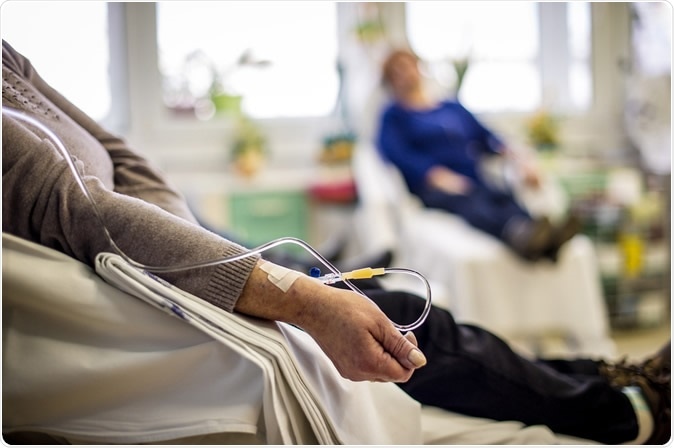The American Cancer Society reports that cancer deaths in the United States have decreased by as much as 29 percent between 1991 and 2017, thanks to early detection and treatment advances.
Published in the New England Journal of Medicine, the new report estimates that there were 2.9 million fewer deaths over a span of 26 years, which was mainly attributable to progress in detecting and treating the four most common cancers, including lung, colorectal, breast, and prostate cancer.

Cancer patients receiving chemotherapy treatment. Image Credit: Napocska / Shutterstock
Decreasing cancer rates
In 2020, it’s expected that the US will have 1,806,590 new cancer cases and 606,520 cancer-related deaths. Over the past decades, the cancer death rate increased until 1991 but fell continuously through 2017, resulting in an overall decline of 29 percent.
The decrease in cancer-related deaths is driven by long-term declines in the four leading causes of deaths but the reduction slowed for colorectal cancer and female breast cancer and stopped for prostate cancer.
On the other hand, the reductions in cases increased for lung cancer, from 3 percent every year in 2008 to 2013, to 5 percent from 2013 to 2017 in men, and 2 percent to about 4 percent in women, making the rate the largest ever single-year decline in overall cancer mortality of 2.2 percent between 2016 and 2017.
Melanoma, a type of skin cancer, has seen a dramatic drop amid the U.S. Food and Drug Administration (FDA)’s approval of new treatments for metastatic disease. Melanoma mortality rate has increased to 7 percent every year in the 2013 to 2017 period, from just 1 percent between 2006 and 2010.
Factors contributing to drop
To land to their findings, the researchers studied the mortality data from 1930 to 2017, which was provided by the National Center for Health Statistics (NCHS). Aside from the new data presented, they also determined factors that have contributed to the decline in cancer deaths.
Many factors have contributed to the decline in lung cancer deaths, including preventing the disease through smoking prevention and cessation programs. For over 25 years, prevention played a vital role in reducing lung cancer. For instance, the smoking rate in adults in the U.S. has decreased to 13.75 percent.
It is well known that smoking tobacco is linked to the development of lung cancer, and prevention can help reduce cancer rates among both smokers and non-smokers.
Apart from prevention, it was shown that improved radon detection and mitigation has helped reduce lung cancer cases, since radon is the second most preventable cause of lung cancer, next to tobacco smoke. Further, early detection of lung cancer is important to initiate treatments promptly, improving the chances of fighting the disease. The earlier the treatment, the better the prognosis of cancer.
Low-dose computed tomography (CT) screening has also played an imperative role in reducing lung cancer deaths. The test is recommended for high-risk patients who were current or former heavy smokers. In fact, detecting lung cancer early through CT has led to about a 20 percent decrease in death rates.
The remainder of the decline can be attributed to advances in treatment. For over two decades, medicine has evolved and due to breakthroughs in discovering new drugs, including immunotherapy, more people were saved from cancer-related deaths.
However, despite its declining numbers over the years, it is still the number one killer, with 228,820 new cases and 135,720 deaths predicted for the US in 2020.
WHO recommends steps to prevent cancer deaths
The World Health Organization (WHO) highlights the importance of prevention and treatment of cancer cases, noting that stepping up cancer services in low and middle-income countries can save millions of lives. If current trends will continue, the WHO warns that the world will see a 60-percent increase in cancer diagnoses over the next 20 years.
The greatest increase or 81 percent of the new cases will likely occur in low-and middle-income countries, where the survival rates are the lowest.
“This is a wake-up call to all of us to tackle the unacceptable inequalities between cancer services in rich and poor countries. If people have access to primary care and referral systems then cancer can be detected early, treated effectively and cured. Cancer should not be a death sentence for anyone, anywhere,” Dr. Ren Minghui, Assistant Director-General, Universal Health Coverage/ Communicable and Noncommunicable Diseases, World Health Organization, said in a statement.
With early detection and providing the current and modern interventions to patients, progress in poorer countries is achievable.
“At least 7 million lives could be saved over the next decade, by identifying the most appropriate science for each country situation, by basing strong cancer responses on universal health coverage, and by mobilizing different stakeholders to work together”, Dr. Tedros Adhanom Ghebreyesus, Director-General, WHO, said.
Sources:
Siegel, R., Miller, K., and Jemal, A. (2020). Cancer statistics, 2020. American Cancer Society: A Cancer Journal for Clinicians. https://acsjournals.onlinelibrary.wiley.com/doi/full/10.3322/caac.21590
World Health Organization (WHO). (2020). WHO outlines steps to save 7 million lives from cancer. https://www.who.int/news-room/detail/04-02-2020-who-outlines-steps-to-save-7-million-lives-from-cancer
Journal reference:
Reduced Lung-Cancer Mortality with Volume CT Screening in a Randomized Trial List of authors. Harry J. de Koning, M.D., Ph.D., Carlijn M. van der Aalst, Ph.D., Pim A. de Jong, M.D., Ph.D., Ernst T. Scholten, M.D., Ph.D., Kristiaan Nackaerts, M.D., Ph.D., Marjolein A. Heuvelmans, M.D., Ph.D., Jan-Willem J. Lammers, M.D., Ph.D., Carla Weenink, M.D., Uraujh Yousaf-Khan, M.D., Ph.D., Nanda Horeweg, M.D., Ph.D., Susan van ’t Westeinde, M.D., Ph.D., Mathias Prokop, M.D., Ph.D., et al. https://www.nejm.org/doi/10.1056/NEJMoa1911793